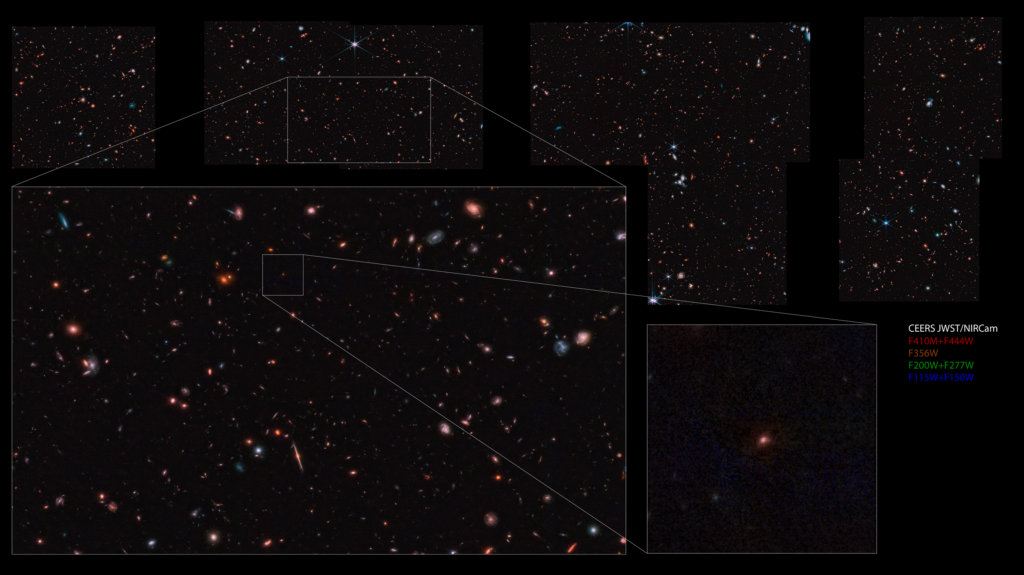2022-08-04 テキサス大学オースチン校(UT Austin)
 Scientists with the CEERS Collaboration have identified an object—dubbed Maisie’s galaxy in honor of project head Steven Finkelstein’s daughter—that may be one of the earliest galaxies ever observed. If its estimated redshift of 14 is confirmed with future observations, that would mean we’re seeing it as it was just 290 million years after the Big Bang. Credit: NASA/STScI/CEERS/TACC/S. Finkelstein/M. Bagley/Z. Levay.
Scientists with the CEERS Collaboration have identified an object—dubbed Maisie’s galaxy in honor of project head Steven Finkelstein’s daughter—that may be one of the earliest galaxies ever observed. If its estimated redshift of 14 is confirmed with future observations, that would mean we’re seeing it as it was just 290 million years after the Big Bang. Credit: NASA/STScI/CEERS/TACC/S. Finkelstein/M. Bagley/Z. Levay.
この銀河は、ビッグバンからちょうど2億9000万年後の姿 (天文学者はこれを赤方偏移 z=14 と呼ぶ) で観測されていると推定されています。
この発見が確認されれば、これまで観測された中で最も古い銀河の一つとなり、その存在は、多くの天文学者がこれまで考えていたよりもずっと早く銀河の形成が始まったことを示すことになります。
<関連情報>
- https://news.utexas.edu/2022/08/04/wide-view-of-early-universe-hints-at-galaxy-among-the-earliest-ever-detected/
- https://arxiv.org/abs/2207.12474
遥かかなたの銀河系で、遠い昔に。JWST初期のCEERS画像に見るz ~ 14銀河の候補天体
A Long Time Ago in a Galaxy Far, Far Away: A Candidate z ~ 14 Galaxy in Early JWST CEERS Imaging
Steven L. Finkelstein, Micaela B. Bagley, Pablo Arrabal Haro, Mark Dickinson, Henry C. Ferguson, Jeyhan S. Kartaltepe, Casey Papovich, Denis Burgarella, Dale D. Kocevski, Marc Huertas-Company, Kartheik G. Iyer, Rebecca L. Larson, Pablo G. Pérez-González, Caitlin Rose, Sandro Tacchella, Stephen M. Wilkins, Katherine Chworowsky, Aubrey Medrano, Alexa M. Morales, Rachel S. Somerville, L. Y. Aaron Yung, Adriano Fontana, Mauro Giavalisco, Andrea Grazian, Norman A. Grogin, Lisa J. Kewley, Anton M. Koekemoer, Allison Kirkpatrick, Peter Kurczynski, Jennifer M. Lotz, Laura Pentericci, Nor Pirzkal, Swara Ravindranath, Russell E. Ryan Jr., Jonathan R. Trump, Guang Yang, Omar Almaini, Ricardo O. Amorín, Marianna Annunziatella, Bren E. Backhaus, Guillermo Barro, Peter Behroozi, Eric F. Bell, Rachana Bhatawdekar, Laura Bisigello, Volker Bromm, Véronique Buat, Fernando Buitrago, Antonello Calabró, Caitlin M. Casey, Marco Castellano, Óscar A. Chávez Ortiz, Laure Ciesla, Nikko J. Cleri, Seth H. Cohen, Justin W. Cole, Kevin C. Cooke, M. C. Cooper, Asantha R. Cooray, Luca Costantin, Isabella G. Cox, Darren Croton, Emanuele Daddi, Romeel Davé, Alexander de la Vega, Avishai Dekel, David Elbaz, Vicente Estrada-Carpenter, Sandra M. Faber, Vital Fernández, Keely D. Finkelstein, Jonathan Freundlich, Seiji Fujimoto, Ángela García-Argumánez, Jonathan P. Gardner, Eric Gawiser, Carlos Gómez-Guijarro, Yuchen Guo, Timothy S. Hamilton, Nimish P. Hathi, Benne W. Holwerda, Michaela Hirschmann, Taylor A. Hutchison, Saurabh W. Jha, Shardha Jogee, Stéphanie Juneau, Intae Jung, Susan A. Kassin, Aurélien Le Bail, Gene C. K. Leung, Ray A. Lucas, Benjamin Magnelli, Kameswara Bharadwaj Mantha, Jasleen Matharu, Elizabeth J. McGrath, Daniel H. McIntosh, Emiliano Merlin, Bahram Mobasher, Jeffrey A. Newman, David C. Nicholls, Viraj Pandya, Marc Rafelski, Kaila Ronayne, Paola Santini, Lise-Marie Seillé, Ekta A. Shah, Lu Shen, Raymond C. Simons, Gregory F. Snyder, Elizabeth R. Stanway, Amber N. Straughn, Harry I. Teplitz, Brittany N. Vanderhoof, Jesús Vega-Ferrero, Weichen Wang, Benjamin J. Weiner, Christopher N. A. Willmer, Stijn Wuyts, Jorge A. Zavala
Comments:
18 pages, 6 figures, 3 tables, Submitted to ApJ
Subjects:
Astrophysics of Galaxies (astro-ph.GA)
Cite as:
arXiv:2207.12474 [astro-ph.GA]
(or arXiv:2207.12474v1 [astro-ph.GA] for this version)
We report the discovery of a candidate galaxy with a photo-z of z~14 in the first epoch of JWST NIRCam imaging from the Cosmic Evolution Early Release Science (CEERS) Survey. We searched for z>12 sources using photo-z’s based primarily on the expected Lyman-alpha breaks. Following conservative vetting criteria, we identify a robust source at z_phot=14.3 (+0.4, -1.1, 1-sig uncertainty) with F277W=27.8, and detections in five (two) filters at >5sig (>10sig) significance. This object (dubbed Maisie’s Galaxy) exhibits a strong F150W-F200W Lyman-alpha break color of >2.5 mag (1sig), resulting in 99.99% (87%) of the photo-z PDF favoring z>10 (13). The source may be marginally detected by HST in F160W, which would widen the lower-redshift bound to z~12.5. This slightly lower-redshift interpretation would require very strong Ly-alpha emission (>300 A rest equivalent width), requiring an extremely early ionized bubble. The colors of this object are inconsistent with Galactic stars, and it is resolved (r_h=0.1+/-0.01″; 330 pc). All data quality images show no artifacts at the candidate’s position. Independent methods are in robust agreement, and we consistently find a strong preference for z>13 with our fiducial photometry. Maisie’s Galaxy appears to be fairly high mass (log M*/Msol~8.5) and highly star-forming (log sSFR ~ -7.9/yr) for this early epoch, with a blue rest-UV color (beta~-2.3) indicating little dust, though not extremely low metallicities. While the presence of this source is in tension with most cosmological simulation predictions and may seriously challenge dark matter models with suppressed small-scale power, it is in agreement with empirical extrapolations from lower redshift assuming a smoothly declining cosmic SFR density. Should followup spectroscopy validate this redshift, our Universe was already aglow with fairly massive galaxies less than 300 Myr after the Big Bang.



